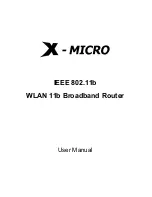
Viper SC+™ IP Router for Licensed Spectrum PN 001-5008-000 Rev. C
| Page 136
APPENDIX A
– ABBREVIATIONS AND DEFINITIONS
Access Point:
Communication hub for users to connect
to a LAN. Access Points are important for providing
heightened wireless security and for extending the
physical range of wireless service accessibility.
AES:
Advanced Encryption Standard.
Airlink:
Physical radio-frequency connection used for
communication between units.
ARP:
Address Resolution Protocol; maps Internet
addresses to physical addresses.
Backbone:
The part of a network connecting the bulk
of the systems and networks together, handling most
of the data.
Bandwidth:
The transmission capacity of a given
device or network.
Browser:
An application program providing the
interface to view and interact with all the information
on the World Wide Web.
COM Port:
Both RS-232 serial communications ports of
the Viper SC and Viper SC+ wireless radio modems are
COM ports configured as DCE and designed to connect
directly to DTE.
CWID:
a station identifier or “call sign” broadcast in
Morse code at specified periodic intervals to identify
the broadcasting radio.
DCE:
Data Communication Equipment
Default Gateway:
A device forwarding Internet traffic
from the Local Area Network (LAN)
DHCP:
Dynamic Host Configuration Protocol; A
networking protocol that allows administrators to
assign temporary IP addresses to network computers
by “leasing” an IP address to a user for a limited
amount of time, instead of assigning permanent IP
addresses.
DNS:
Domain Name Server; Translates the domain
name into an IP address.
Domain:
A specific name for a network of computers.
DTE:
Data Terminal Equipment; This designation is
applied to equipment such as terminals, PCs, RTUs,
PLCs, etc. DTE is designed to connect to DCE.
Dynamic IP Address:
A temporary IP address assigned
by a DHCP server.
Ethernet:
IEEE standard network protocol that
specifies how data is placed on and retrieved from a
common transmission medium.
Firewall:
A set of related programs located at a
network gateway server that protects the resources of
a network from users on other networks.
Firmware:
The embedded programming code running
a network device.
Fragmentation:
Breaking a packet into smaller units
when transmitting over a network medium that cannot
support the original size of the packet.
FTP:
File Transfer Protocol; A protocol used to transfer
files over a TCP/IP network.
Gateway:
A device interconnecting networks with
different, incompatible communications protocols.
HDX:
Half-Duplex; Data transmission occurring in two
directions over a single line, using separate Tx and Rx
frequencies, but only in one direction at a time.
HMI:
Human Machine Interface. Button panel,
keyboard, or touch-screen equipped device that
provides a means of human interaction in controlling
devices.
HTTP:
Hypertext Transfer Protocol; Communications
protocol used to connect to servers on the World Wide
Web.
IPconfig:
Internet Protocol Configuration; A console
application available in Microsoft Windows and Mac
OS X that displays all current TCP/IP network
configuration values. Displays the IP address for a
particular networking device.
LAN:
Local Area Network.
















































